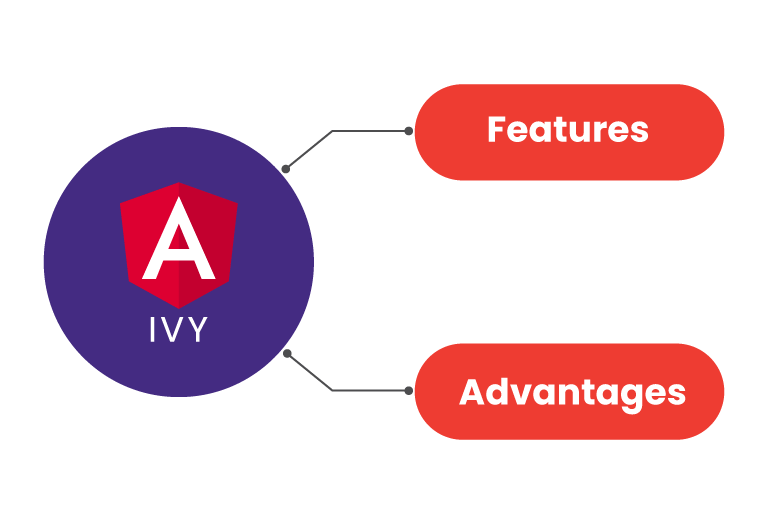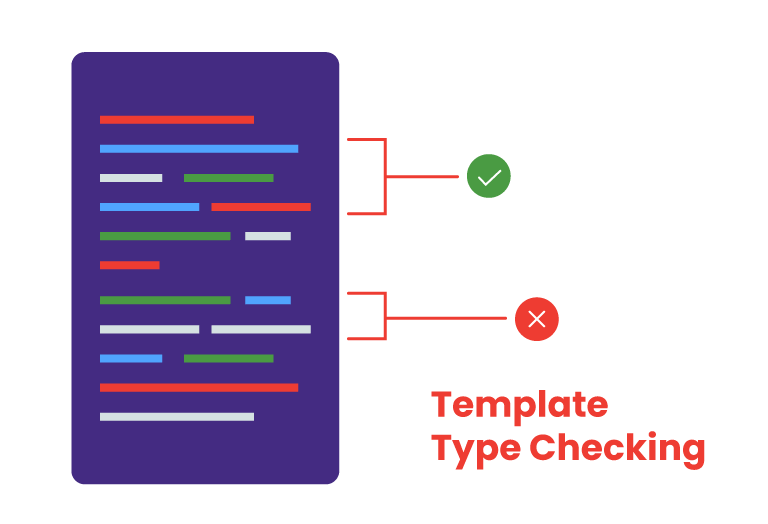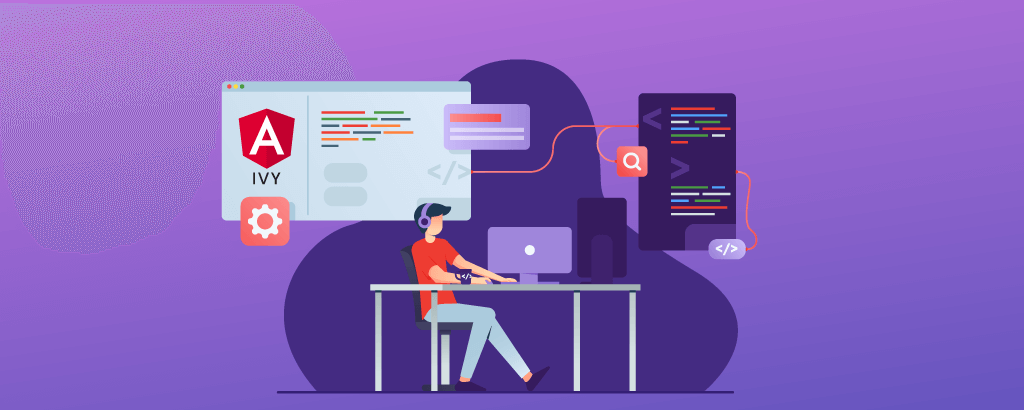Embracing the Power of Ivy: Revolutionising Angular
The release of Angular Ivy at ng-conf represents a huge advancement in web development. Even though it isn’t yet completely production-ready, now is the perfect opportunity to investigate this new Angular renderer. The release of Angular Ivy, offers promising opportunities for businesses that depend on Angular development services. Angular 9 Ivy features include ground-breaking features like support for web workers, a new builder API, and differential loading. Accepting Angular Ivy opens the door to a better future for web development, bringing improved performance and simplified procedures. Hire a reputable Angular Ivy development company to build angular ivy apps and unlock the full potential of this revolutionary technology.
The Game-Changer: Unveiling the Key Features and Advantages of Angular 9 Ivy
The most common challenge for anybody who is into Angular Ivy web development is on how to handle Mobile devices. It might seem extremely out of context but statistics state that nearly 63% of US online traffic comes from tablets and smartphones. When this year ends, internet usage through mobile devices is going to be around 80%, . The topmost challenge faced by any front end developer is while they are loading the website. Many times, mobile devices have been found to be a victim of slow or bad internet connection. This has been the most crucial challenge which they had to tackle. We also have the liberty to use a number of solutions while we look forward to load every application in a faster manner. We can leverage CDN to serve every file from the closest cloud. Using PWA, we can cache all the assets. The topmost opportunity for developers is to reduce the bundle size. These are few of the Angular Ivy advantages. To take an example, eliassy.dev is a website built using Angular. It has simple and amazing features as well.
online traffic comes from tablets and smartphones. When this year ends, internet usage through mobile devices is going to be around 80%, . The topmost challenge faced by any front end developer is while they are loading the website. Many times, mobile devices have been found to be a victim of slow or bad internet connection. This has been the most crucial challenge which they had to tackle. We also have the liberty to use a number of solutions while we look forward to load every application in a faster manner. We can leverage CDN to serve every file from the closest cloud. Using PWA, we can cache all the assets. The topmost opportunity for developers is to reduce the bundle size. These are few of the Angular Ivy advantages. To take an example, eliassy.dev is a website built using Angular. It has simple and amazing features as well.
Easier to publish
While wanting to publish NPM Angular library, compiling your TypeScript code to JavaScript has become important. After this, you have got to run your Angular compiler while generating your metadata.json files.
Rebuild times
So when a library is already compiled, then we don’t have to recompile it every time. Great. But it also turns out that previously, when you were working on your application, Angular had to recompile everything inside your module to know what had changed, because the generated code of a component could be using internal details of another component. That seems like an implementation detail, but it has consequences on the rebuild time as the Ivy compiler can do better than to recompile everything as the View Engine did. A little trivia of Angular history: modules were introduced fairly lately in Angular development, just a few months before the stable release.
Bundle sizes
With the new instruction set, you can achieve every goal that has been mentioned. We have designed it to look perfectly tree-shakeable. This shows that while not using a particular Angular feature, the final bundle would not contain the instruction belonging to the feature. The Ivy runtime would never have the code where you have to run the instruction. The View Engine is also not tree-shakeable. It has always held something. Hence the team goes on to expect larger improvements on every small application for your Angular Element. After Ivy’s first release, the situation should not change for the application.
Runtime performances
Angular Ivy advantages include avoiding meta-morphic calls. This has been the foremost concern of everyone who is into mobile application development. Angular Ivy offers a better solution to tackle this problem.
Better template type checking
We need to leverage better options for template type checking. Angular Ivy is here to offer everything that is needed for you in front-end development. The Angular compiler consists of a  better option which is not looked properly by the people in a general opinion: fullTemplateTypeCheck. While you can enable this, your compiler would try to analyze every template in a more deeper manner. This option was extremely powerful when it was introduced under Angular Ivy. Every component has now gone on to refer every directives along with different components it would use for their public APIs. Hence while modifying an internal detail, you can only recompile the actual components you need to use. This can have a number of benefits while you are opting for rebuild times. You would end up recompiling only what is required over here. When you want to compile an existing AppComponent which leverages PonyComponent in its original template, Ivy need not know much about the Pony component. The basic output for AppComponent would depend exclusively on the AppComponent code. This was not the case in ViewEngine. Here whatever code you generate in AppComponent would also depend on the PonyComponent code.
better option which is not looked properly by the people in a general opinion: fullTemplateTypeCheck. While you can enable this, your compiler would try to analyze every template in a more deeper manner. This option was extremely powerful when it was introduced under Angular Ivy. Every component has now gone on to refer every directives along with different components it would use for their public APIs. Hence while modifying an internal detail, you can only recompile the actual components you need to use. This can have a number of benefits while you are opting for rebuild times. You would end up recompiling only what is required over here. When you want to compile an existing AppComponent which leverages PonyComponent in its original template, Ivy need not know much about the Pony component. The basic output for AppComponent would depend exclusively on the AppComponent code. This was not the case in ViewEngine. Here whatever code you generate in AppComponent would also depend on the PonyComponent code.
Locality
Locality refers to the fact that Ivy would be compiling one file at a particular time. It would only take a look at the templates and the components, but not at the other features. When you compile one file at a particular time, it would mean less instructions. It would also refer to the fact that you can add on incremental builds. Ivy would provide the best results involving this with compressions. There would also be a great opportunity where you can dynamically generate different components, modules along with pipes.
Tree-Shaking
Tree-shaking refers to the fact that unused codes can be removed. It is handled with the help of static analysis. This does not run any code. The team of Ivy has designed Ivy with Tree-Shaking in mind. Iv can result in breaking down things into smaller, atomic functions. The atomic functions would go on to make your renderer code quite user-friendly.
The tree-shakable features of Angular include:
- Template syntax
- Content projection
- Dependency injection
- Structural directives
- Pipes
- Listeners
- Lifecycle hooks
- Queries
Cons of Ivy
Ivy offers very less future possibilities. You should now be able to run any application without the help of zone.js. You should also be in a position to semi-manually handle every change detection. The already existing APIs are not documented yet.
Angular Ivy vs React
React is similar to Angular in many ways but has its own pros and cons. Version 16.12.0 features include in the case of angular Ivy vs react:
React DevTools — This would also include a profiler which we have improved with the help of onRender callback.
Utility called act() — This can emulate testing apps easily.
Fixes — This can help you handle every infinite loops, memory leaks, and so on.
With Pattem Digital, release your own form of Angular Ivy
Pattem Digital is the best option for your needs when it comes to about Angular Ivy app development company. Our team is committed to offering straightforward solutions that satisfy your needs. We are available to help you whether you need professional direction, support, or all-inclusive Angular development services. Put your faith in our knowledge and experience to satisfy your unique needs with excellent solutions. Find out why Pattem Digital is the best partner for your Angular Ivy development projects by getting in touch with us right away.


